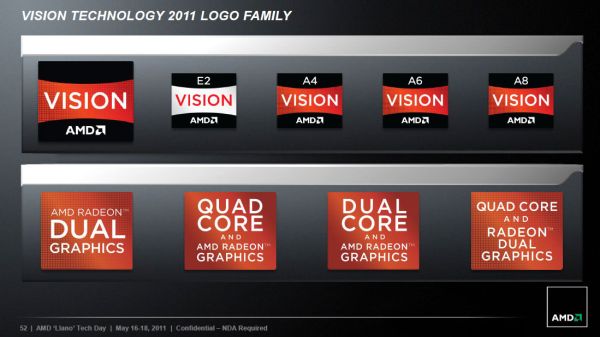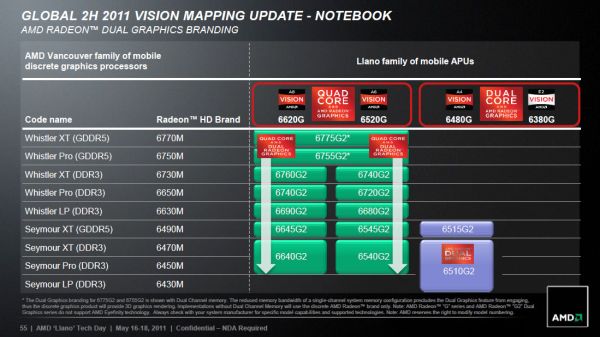The AMD Llano Notebook Review: Competing in the Mobile Market
by Jarred Walton & Anand Lal Shimpi on June 14, 2011 12:01 AM ESTIntroducing Mobile Llano
Anand has provided our coverage of Llano’s architecture and he’ll have a preview of desktop performance, but he’s leaving the mobile coverage to me (Jarred). At a high level, the breakdown of Llano is really quite simple: take a K10.5 series CPU core (dual- or quad-core), pair it up with a DX11 capable GPU core similar to AMD’s Redwood line (5600/5600M or 6500M), and then mix in power gating and Turbo Core; bake everything in a 32nm process and you’ve got Llano. Easier said than done, of course, as K10.5 parts previously used a 45nm process while Redwood used 40nm, so AMD had plenty of work to do before they could realize the simplistic overview I just described; the result is what matters, though, so let’s break out our spoons and see how the pudding tastes. Here’s the overview of the mobile A-series APUs launching today.
| AMD A-Series Fusion APUs for Notebooks | |||||||
| APU Model | A8-3530MX | A8-3510MX | A8-3500M | A6-3410MX | A6-3400M | A4-3310MX | A4-3300M |
| CPU Cores | 4 | 4 | 4 | 4 | 4 | 2 | 2 |
| CPU Clock (Base/Max) | 1.9/2.6GHz | 1.8/2.5GHz | 1.5/2.4GHz | 1.6/2.3GHz | 1.4/2.3GHz | 2.1/2.5GHz | 1.9/2.5GHz |
| L2 Cache (MB) | 4 | 4 | 4 | 4 | 4 | 2 | 2 |
| Radeon Model | HD 6620G | HD 6620G | HD 6620G | HD 6520G | HD 6520G | HD 6480G | HD 6480G |
| Radeon Cores | 400 | 400 | 400 | 320 | 320 | 240 | 240 |
| GPU Clock (MHz) | 444 | 444 | 444 | 400 | 400 | 444 | 444 |
| TDP | 45W | 45W | 35W | 45W | 35W | 45W | 35W |
| Max DDR3 Speed |
DDR3- 1600 DDR3L- 1333 |
DDR3- 1600 DDR3L- 1333 |
DDR3- 1333 DDR3L- 1333 |
DDR3- 1600 DDR3L- 1333 |
DDR3- 1333 DDR3L- 1333 |
DDR3- 1333 DDR3L- 1333 |
DDR3- 1333 DDR3L- 1333 |
There are two different power envelopes for Llano right now: 35W and 45W. The former models end with an M while the latter end in MX. Don’t let the relatively high TDPs fool you, as similar to Intel we’re looking at maximum TDP while idle and low-load TDP will be far lower. Based on battery life, it appears that the entire test notebook consumes around 7.42W at idle. By comparison, a slightly larger dual-core SNB notebook consumes around 7.68W when idle, so we’re very close to parity at idle. As noted earlier, all APU models come with 1MB L2 cache per core, and Turbo Core allows for cores to clock up to higher values under the right circumstances. That could prove important, as clock-for-clock K10.5 cores can’t hope to keep up with Sandy Bridge, and Sandy Bridge parts are already clocking significantly higher.
On the CPU side of the equation, there are currently only dual-core and quad-core parts, so tri-core appears dead (or at least MIA for now). The other part of the APU is the GPU cores, and here there are three options. The A6 and A8 APUs are both quad-core, but A6 has 320 Radeon cores clocked at 400MHz compared to 400 cores at 444MHz—so the 6620G is potentially 40% faster. A4 APUs trim the GPU further, with 240 cores clocked at 444MHz, and they’re the dual-core parts. The 6620G could be up to 67% faster than 6480G, under the right circumstances. As Anand mentioned, right now all of the A-series APUs are coming from the “big Llano” die, but in the future we’ll see the A4 production shift to “little Llano” instead of using harvested die.
Vision and Radeon Branding
For 2011, AMD is simplifying their Vision branding with Llano, skipping the Premium, Ultimate, and Black modifiers and instead referring to the APU. Vision E2 refers to the dual-core E-series APUs, while the A4, A6, and A8 lines correlate directly with the A-series APUs. The Radeon brand continues as an important asset, so there will be sticker options to promote quad-core and dual-core CPUs with Radeon graphics. What about the Dual Graphics, though?
With the integrated GPU finally able to approach the performance of midrange mobile GPUs, AMD is making a return to hybrid CrossFire (IGP and a dGPU working together), though the official name is now apparently “Radeon Dual Graphics” or just "Dual Graphics"; we’ve also heard it referred to as “Asymmetrical CrossFire”, and we’ll use any of these terms throughout this article.
We first saw an attempt at hybrid CrossFire with the HD 2400 and the 790 chipset, and later that extended to HD 3400 cards, but it never really impressed as it was limited to desktops and you could still get far better performance by spending an extra $10 to upgrade from a 3400 to a 3600 dGPU. The 6620G fGPU is several times more powerful than the old HD 4250 IGP, making CrossFire potential useful, especially on laptops where the power savings from shutting off the dGPU are very significant.
With Radeon Dual Graphics, AMD introduces more brands. The various Fusion GPUs (fGPUs) only work in CrossFire with specific discrete GPUs (dGPUs)—nearly all of the 6400M, 6600M, and 6700M line are eligible—giving rise to several new Radeon names. If you start with a base of a Radeon HD 6620G and add a Radeon HD 6770M to it, the resulting combination is now called a Radeon HD 6775G2. Pair it with a 6750M and you get a 6755G2. The entirety of the list is depicted in the slide from above. For now these names are just going to be listed on the notebook spec sheet, the drivers themselves will report the actual GPU you have driving the panel you're connected to. AMD is still working out the right way to expose these names through software to avoid confusion.












177 Comments
View All Comments
duploxxx - Sunday, June 19, 2011 - link
talking about crap??? men you are good at that, as if you need a 2600K for some compiling and add a 6990 to an e-350.men you do know someting about computers :) your a joke
BushLin - Wednesday, June 22, 2011 - link
If you're going to accuse someone of talking crap (correctly or otherwise) it helps if you know the difference between you're and your when attempting to insult them.Broheim - Monday, June 27, 2011 - link
I use a fast CPU for compiling because I actually like being productive rather than just staring at the screen.my point about the 6990 was that a faster GPU != a better user experience for the vast majority of users, but logic seems to be lost on you.
Regenweald - Tuesday, June 14, 2011 - link
I'm currently playing the Witcher extended with a 2Ghz X2 ,a 4670 and 800 Mhz memory on a desktop with no complaints. In game settings medium and high. Are you saying that 2 more tweaked 32nm cores, 80 more shaders and ddr3 1600 or 1800 memory will not offer a good mobile gaming experience ? please.jollyjugg - Wednesday, June 15, 2011 - link
What kind of super computing application are you going to do in your laptop that you would need that "tremendous CPU power" that you are talking about. As somebody who has used both intel and amd machines for years I can tell you that for most user applications, you will hardly notice any difference in performance. The main complaint was that AMD machines were running hot particularly after intel cameup with power gating in nehalem in 2008. With this part you get a machine that runs way way cooler and almost 150- 200 bucks cheaper than comparable intel machines plus you get discrete quality graphics for free. Nobody can change cynics like you. Because you cant expect Intel to sell anything cheap you would want to AMD to sell things cheaper. Well if you want good things in life you should be prepared to pay. Dont write trash. Like gaming is not important for average user, tremendous computing power and 3 GHz CPU speed is also not important for the average PC user. But multimedia and movie rendering etc is. So go Llano!!!Seikent - Tuesday, June 14, 2011 - link
This platform offer some good things, but if the prices aren't low it won't go well. Now it's quite easy to find a sandy bridge notebook with discrete gpu for a few more dollars.If ACF does achieve to work like CF in the future, it would be great!
SteelCity1981 - Tuesday, June 14, 2011 - link
Finally we have an intergrated graphics solution that's worth really talking about.aegisofrime - Tuesday, June 14, 2011 - link
Judging by the performance, this part won't be priced very high. And that's a worry, considering that it packs 1.45 billion transistors. In comparison, Sandy Bridge is 995 million transistors, and sells for more money. Profit margins are gonna be tight on this one.JarredWalton - Tuesday, June 14, 2011 - link
AMD has a slide that points out that compared to their previous generation, they're packing a 66 mm2 Northbridge, 200 mm2 CPU, and 1080 mm2 dGPU into a 228 mm2 package. They've made money this past quarter, so this should do better than Athlon/Phenom II.JarredWalton - Tuesday, June 14, 2011 - link
Note: that's supposed to be 108 mm2 GPU, not 1080. Whoops.